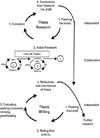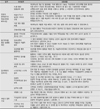Abstract
Purpose
The purpose of this study was to examine the effectiveness of Action Research (AR) approach in nursing.
Methods
Participants were 64 perioperative nurses recruited from C hospital in Gwangju, Korea. The nurses were engaged in the project through 2 cycles of planning, acting, observing, and reflecting. A mixed-methods design was used to examine changes in participants and their knowledge management practice. Quantitative data were analyzed using SPSS 20.0 program and qualitative reflection data underwent content analysis.
Results
During the project, participants developed standardized pre-operative checklists and opened an Internet Cafe to better manage their perioperative nursing information. At the end of the project, there was a significant increase in nurses' knowledge management (p=.015) and the rate of surgical material prescription errors decreased from 8.0% to 2.9%. Core AR project team members' teamwork skills and organizational commitment increased significantly (p=.040, p=.301, respectively). The main themes that emerged from the qualitative data were learning how to solve problems in practice, facilitating team activities through motivation, barriers of large participation, and rewarded efforts and inflated expectations.
Figures and Tables
References
1. Blum CA. Development of a clinical preceptor model. Nurse Educ. 2009. 34:29–33. http://dx.doi.org/10.1097/01.NNE.0000343394.73329.1d.
2. Greenwood J. Nursing research: a position paper. J Adv Nurs. 1984. 9:77–82. http://dx.doi.org/10.1111/j.1365-2648.1984.tb00346.x.
3. Herr K, Anderson GL. The action research dissertation: A guide for students and faculty. 2005. London: Sage.
4. Holter IM, Schwartz-Barcott D. Action research what is it? How has it been used and how can it be used in nursing? J Adv Nurs. 1993. 18:298–304. http://dx.doi.org/10.1046/j.1365-2648.1993.18020298.x.
5. Hunt M. The process of translating research findings into nursing practice. J Adv Nurs. 1987. 12:101–110. http://dx.doi.org/10.1111/j.1365-2648.1987.tb01308.x.
6. Jeong SH. Relationship between knowledge management process and organizational effectiveness in clinical nurses. J Korean Acad Nurs Adm. 2003. 9:415–427.
7. Jeong SH, Lee KS, Lee MH, Kim IS. A study on the development of the learning organization measurement. J Korean Acad Nurs Adm. 2003. 9:75–88.
8. Kim BY. An action research for parent empowerment. of married immigrant women. 2011. Gwangju, Korea: Chonnam National University;Unpublished doctoral dissertation.
9. Kim MO. Utilities and application of action research in Korean social welfare research. Korean J Soc Welf. 2009. 61:179–204.
10. Kim YM. Evaluation of design and operation of action learning based nursing professionalism course for nursing students. 2012. Gwangju, Korea: Chonnam National University;Unpublished doctoral dissertation.
11. Koshy E, Koshy V, Waterman H. Action research in healthcare. 2011. London: Sage.
12. La Pine MP. The domain of nursing: Developing practice through action research in the intensive care unit. 2008. Victoria University of Wellington;Unpublished master's thesis.
13. Lee MH. Relationship between organizational culture types and organizational effectiveness in hospitals. 1998. Daejeon, Korea: Chungnam National University;Unpublished doctoral dissertation.
14. Lee YS, Kim YM, Kim YC, Lee HK, Cho DJ. Action research as a bridge between research and teaching: The transformation of the M. A. thesis research method in graduate school of education. J Yeolin Educ. 2004. 12(1):363–402.
15. MacGuire JM. Putting nursing research findings into practice: Research utilization as an aspect of the management of change. J Adv Nurs. 1990. 15:614–620. http://dx.doi.org/10.1111/j.1365-2648.1990.tb01861.x.
16. Marshall LC. The relationship between efficacy, teamwork, effort and patient satisfaction. 2003. University of Southern California;Unpublished doctorial dissertation.
17. McCaugherty D. The theory-practice gap in nursing education: Its cases and possible solutions. Findings from an action research study. J Adv Nurs. 1991. 16:1055–1061. http://dx.doi.org/10.1111/j.1365-2648.1 991.tb03366.x.
18. McKeller L, Pincombe JI, Henderson AN. Action research: A process to facilitate collaboration and change in clinical midwifery practice. Evid Based Midwifery. 2010. 8:85–90.
19. Mendenhall TJ, Berge JM, Harper P, GreenCrow B, LittleWalker N, WhiteEagle S, BrownOwl S. The Family Education Diabetes Series (FEDS): Community-based participatory research with midwestern American Indian community. Nurs Inq. 2010. 17:359–372. http://dx.doi.org/10.1111/j.1440-1800.2010.00508.x.
20. Mills GE.
SW Kang
. Action research: A guide for the teacher researcher. 2005. Seoul: Uriedu;(Original work published in 2003).
21. Morton-Cooper A. Action research in health care. 2000. London: Blackwell Science.
22. Mowday RT, Steers RM, Porter LW. The management of organization commitment. J Vocat Behav. 1979. 14:224–247.
23. Munn-Giddings C, McVicar A, Smith L. Systematic review or the uptake and design of action research in published nursing research. J Res Nurs. 2008. 13:465–477. http://dx.doi.org/10.1177/1744987108090297.
24. O'Neil H, Chung G, Brown R. O'Neil HF, editor. Use of networked simulations as a context to measure team competencies. Workforce readiness: competencies and assessments. 1997. Mahwah, NJ: Lawrence Erlbaum Associates;411–452.
25. Shelton D. Establishing the public's trust through community-based participatory research: A case example to improve health care for a rural Hispanic community. Annu Rev Nurs Res. 2008. 26:237–259.
26. Sung YK. A theoretical investigation on the development and some critical issues in curriculum action research. J Curriculum Stud. 2006. 24(2):87–109.
27. Tashakkori A, Teddlie C. Handbook of mixed methods. 2003. CA: Sage Publication.
28. Taylor BJ. Reflective practice for healthcare professionals a practical guide. 2010. 3rd ed. Berkshire: Open University Press.
29. Williamson GR, Bellman L, Webster J. Action research in nursing and healthcare. 2012. London: Sage.
30. Zuber-Skerritt O, Fletcher M. The quality of an action research thesis in the social sciences. Qual Assur Educ. 2007. 15:413–436. http://dx.doi.org/10.1108/09684880710829983.




 PDF
PDF ePub
ePub Citation
Citation Print
Print









 XML Download
XML Download